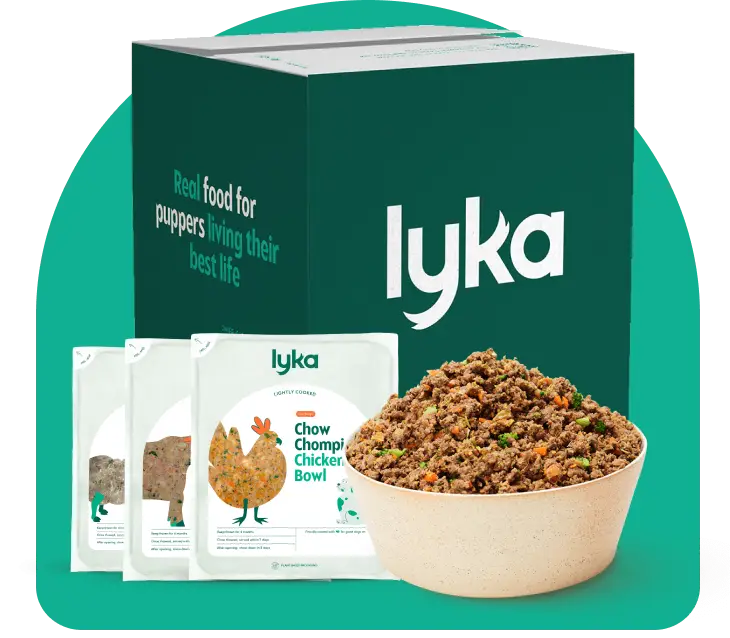Our carbon emissions & how we offset

By Tara Wesson

If you’ve ever wondered about your pup’s environmental footprint, you’re not the only one. While we all know they can do no wrong, it’s worth considering – especially when it’s possible to do better for our environment.
Together with our pupper parents, we’re leading the charge towards net zero. With Greenfleet as our partner, we’re regenerating ecosystems across the nation. One bowl at a time.
First, we’ll get into the “how” and “why” of greenhouse gases. If you’re already up to speed, skip straight to the breakdown of our recipes’ carbon impact.
What are greenhouse gases (GHG) and why are they bad?
There are four types of greenhouse gases (collectively known as CO2eq or carbon dioxide equivalent). This is the unit we’ve based our calculations on.
When these gases are released and trapped in the atmosphere, they act as a hot blanket. Over time, this increases the Earth’s average temperature.
Carbon dioxide (CO2) forms 79% of all GHG. It’s emitted by burning organic materials: like coal, oil, gas, wood and solid waste. It can stay in the atmosphere for thousands of years, and is at approximately 420ppm (parts per million) — a whopping 5% increase in the last 10 years.
Methane forms 11% of all GHG, but its warming effects are 84 times stronger than carbon dioxide. It’s emitted by badly managed landfills and animal husbandry (mostly cattle and sheep) — as well as resulting from natural gas and petroleum extraction. Methane stays in the atmosphere for about 20 years.
Nitrous oxide forms 7% of all GHG. It’s emitted by fertiliser, manure, and the burning of agricultural residues and fuel. While it can stay in the atmosphere for over a century, it does the most damage in its first 20 years (with 26 times the warming effect of CO2eq).
Fluorinated gases form 3% of all GHG. These gases (like chlorofluorocarbon and haloalkanes) are emitted by refrigerants, solvents, manufacturing, and sometimes as by-products. Their heat-trapping properties are thousands of times stronger than carbon dioxide, and they’re the main reason behind the ozone layer hole.
Our recipes and what they emit
Now you’ve heard the bad news, it’s time for the good news. At Lyka, we offset our emissions — making us Australia’s only carbon negative pet food company.
Our beef recipe emits 16.19 kilograms of CO2eq.
Our lamb recipe emits 14.00 kilograms of CO2eq.
Our turkey recipe emits 6.52 kilograms of CO2eq.
Our chicken recipe emits 5.29 kilograms of CO2eq.
Our kangaroo recipe emits 3.92 kilograms of CO2eq.
Across all recipes, this brings our emissions (per kilogram) to 10.9 kilograms of CO2eq.
Don’t see fish? As fish is a new Lyka recipe, the team is currently adding it to our carbon emissions tracking model. We’ll update this page once it’s in the system, but we’re expecting it to be on the lower end of our range!
Here’s how we calculated these numbers
Our carbon emissions tracking model includes things like choice of protein, transportation, energy, refrigeration, and more. This data is verified by Pangolin Associates: a sustainability consultancy approved by Climate Active.
“Without our pupper parents, we wouldn’t have nearly the level of impact that we do. Climate action is only possible if we all work together, and our community and suppliers are a great example of this. As we continue to grow, we’ll keep you up to date on what we’re doing to minimise our footprint and take responsibility for all our emissions.” — Gabriel Guedes, COO & CFO of Lyka
In 2022, Lyka offset 10,950 tonnes of CO2eq. This is equivalent to saving the emissions from…

How does Lyka compare to the alternatives?
For a 12kg dog, kibble has an annual footprint of 1,600kg of CO2eq. If the dry food industry was a country of its own, it would rank 60th in the world for its emissions (according to a study from the University of Edinburgh. This is greater than countries like Sweden, Norway, Switzerland and Denmark!
Here are a few ways we keep our bowls below zero:
Our production team uses biodegradable tape, gloves and bin liners. Your box’s insulation is also biodegradable — and we’ll soon be rolling our bioplastic meal pouches.
After cooking our proteins, we give away the residual fat – it gets turned into biodiesel. This reduces the footprint of our higher CO2eq recipes like beef and lamb.
We use the ugly bunch, to reduce carbon emitted from decomposing veggies (that would otherwise go to waste). We work with our suppliers: encouraging the use of reusable containers as much as possible. This means fewer rubber bands, plastic bags, and cardboard boxes. In other words, less material waste.
We source 90% of our ingredients here in Australia. Big kibble companies, however, often have a global supply chain.
Kibble is cooked at extremely high temperatures. This process takes a large amount of energy to power, and is often done with coal and other fossil fuels. Lyka’s meals facility is powered by solar panels.
As a pack, it’s up to us to offset our pups’ carbon pawprint. Planting trees is one way of doing this: but it forms part of a much larger effort here at Lyka. Learn more about our sustainability initiatives and see where your subscription is being put to work.




